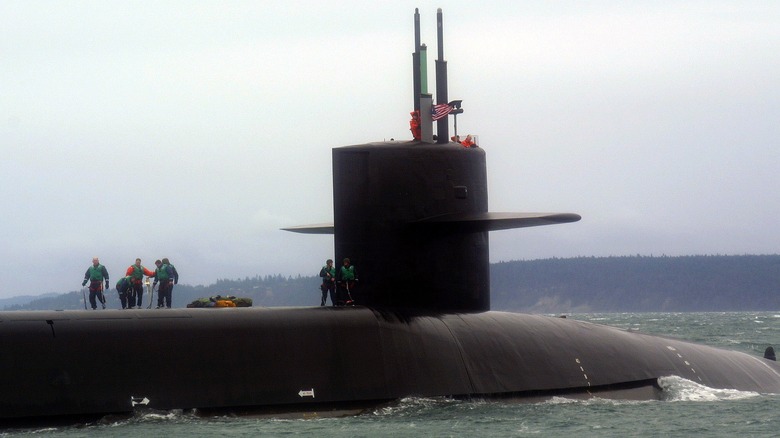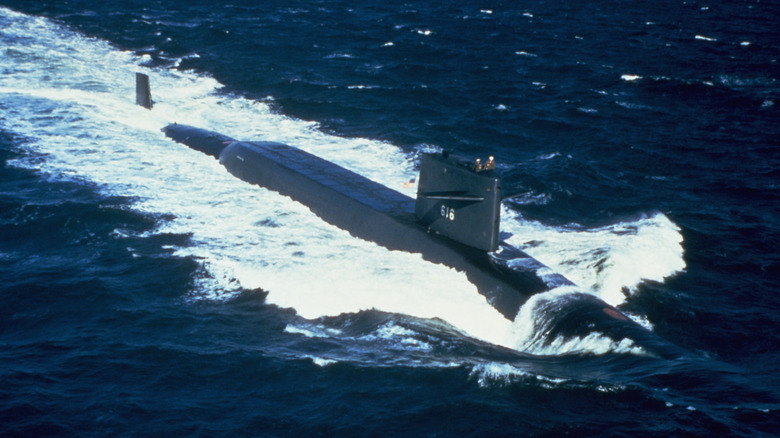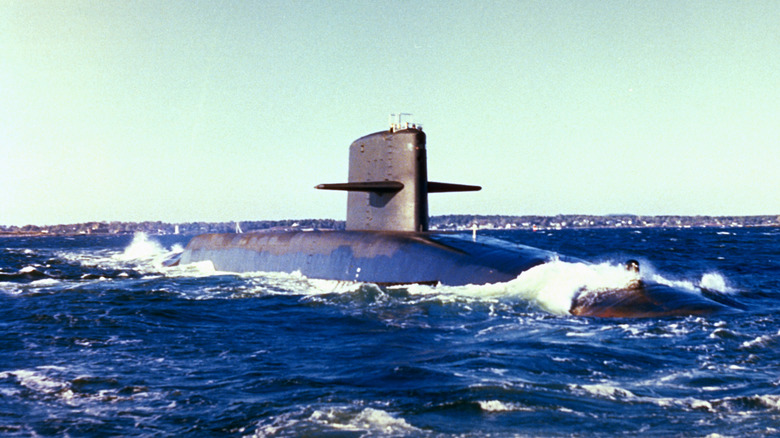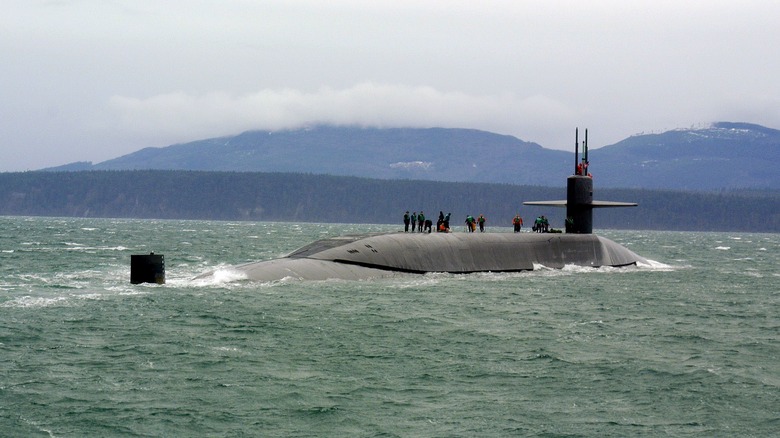Why The Ohio Class Submarine Is The Best Unused Weapon In The U.S. Arsenal
In "Spies Like Us," General Sline comments on America's nuclear arsenal, saying, "A weapon unused is a useless weapon." This can be true, but seeing as the U.S. and the Soviet Union followed the practice of Mutually Assured Destruction (MAD), nuclear arms aren't at all useless. They exist, so they cannot be used, which sounds contrary to common sense, but given the scope of their destructive power, nukes are best left unused.
The U.S. maintains a defense triad consisting of land-based nuclear missiles, strategic bombers capable of carrying and delivering nuclear weapons, and a submarine fleet that can strike anywhere in the world. The U.S.'s Ohio-class submarines were purpose-built to carry 20-24 UGM-133 Trident II D5 missiles, each of which can carry a variety of nuclear warheads. This ensures that any Ohio-class sub can destroy up to 192 targets, as each missile can carry up to eight warheads, depending on the yield.
While the U.S. remains the world's only nation to use nuclear weapons in combat, that's not something the country wants to repeat. By maintaining a massive fleet of secret nuclear submarines capable of sitting off the coasts of any nation undetected, the U.S. effectively shields itself from a first-strike hit. Essentially, if the world knows these submarines exist, they're not going to risk it all to strike the States with a single warhead.
What is an Ohio-class ballistic missile submarine?
As of early 2024, the U.S. maintains a fleet of 18 active Ohio-class submarines, 14 of which are ballistic missile submarines, with the rest being guided-missile subs. They first entered the inventory in 1981, and they've been operating ever since. Each sub displaces 18,750 tons of water while submerged, is 560 feet long, and houses a crew of 140 enlisted and 15 officers. A nuclear reactor powers Ohio-class subs via two geared turbines, and they carry an auxiliary diesel engine.
Ohio-class subs can travel at 14 mph on the surface and around 23 mph while submerged. With their nuclear power plant, the subs can remain at sea almost indefinitely and are only limited by their food stores and personnel needs. That makes them excellent loiter subs. Their entire purpose is to travel about the oceans of the world, avoiding detection by any and all means necessary. Of course, they're not defenseless should they be found.
Ohio-class submarines have four 21" Mark 48 torpedo tubes in addition to their ballistic missiles. They're also outfitted with various sensors, fire control systems, sonar, navigation arrays, and communications equipment. Regarding their missiles, they have no set targets and can receive these through electronic communications almost instantly, allowing submariners to add targeting data quickly to facilitate launches.
What do they cost?
Ohio-class submarines aren't cheap, and that's not surprising given their capabilities, size, and ability to function for nine years before refueling its core. According to Executive Gov, the U.S. spent $3.64 billion on each Ohio-class submarine. It's unclear if this is adjusted for inflation, as construction ended in 1997. Regardless, that's a significant chunk of change for any nation, even one as wealthy as the U.S.
Granted, that's the cost of construction, and operating costs are entirely different. The Navy must pay its sailors, maintain each sub and its systems, and keep them floating... well, submerged. According to the Congressional Budget Office, the cost of operating the entire fleet of Ohio-class ballistic missile submarines for 2023-2032 is estimated to be $188 billion. There are 18 subs, so a sub's annual operating cost is around $1.16 billion.
On top of their use as silent nuclear weapon delivery systems, a new modernization program aims to refit several Ohio-class subs to deliver cruise missiles with non-nuclear payloads. This effort brings the Ohio-class sub into the modern age while retaining the characteristics that make it an effective killing machine — only on a smaller and less horrific scale. The cost of these missile conversion overhauls is between $700 and $900 million.
Why keep using Ohio-class submarines?
Throughout the entirety of their service, Ohio-class submarines haven't delivered a nuclear payload. That's a good thing, but it does beg the question, 'Why pay some $45+ billion over the life of a submarine that's never used?' The simple answer is that the U.S. does use them — as a nuclear deterrent. Hearkening back to General Sline's comment in "Spies Like Us," an unused nuclear weapon is more useful than one that's detonated, seeing as nobody wants to unleash nuclear armageddon.
Of course, there are those who would argue to the contrary, but seeing as the U.S. never used a nuclear weapon in combat after 1945, it's safe to say the strategic nuclear triad has proven useful. Also, with the Ohio-class' missile conversion overhaul, these subs are becoming more valuable in tactical strike operations around the globe. Refitted subs can fire the Tomahawk land-attack cruise missile, which costs a measly $1.5 million each and can hit targets 1,500 miles away.
This upgrade revitalizes the Ohio-class submarine fleet, making it an effective combat platform for non-nuclear operations. Despite their refit, plans to replace the current fleet of Ohio-class subs began in the early aughts. A new Columbia-class submarine will take over Ship, Submersible, Ballistic, and Nuclear (SSBN) operations by 2031. While this is the current plan, the Ohio-class fleet will likely extend its life well beyond that point, so they'll likely remain active for at least a decade, if not longer.



